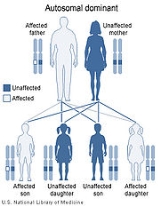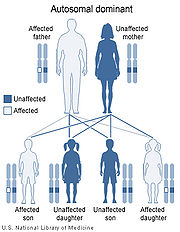
Pallister-Hall syndrome
Encyclopedia
Pallister-Hall syndrome is a disorder that affects the development of many parts of the body.
It is named for Judith Hall and Philip Pallister.
), and the skin between some fingers or toes may be fused (cutaneous syndactyly). An abnormal growth in the brain
called a hypothalamic hamartoma is characteristic of this disorder. In many cases, these growths do not cause any medical problems; however, some hypothalamic hamartomas lead to seizures or hormone abnormalities that can be life-threatening in infancy. Other features of Pallister-Hall syndrome include a malformation of the airway called a bifid epiglottis, laryngeal cleft
, an obstruction of the anal opening (imperforate anus
), and kidney
abnormalities. Although the signs and symptoms of this disorder vary from mild to severe, only a small percentage of affected people have serious complications.
gene provides instructions for making a protein that controls gene expression
, which is a process that regulates whether genes are turned on or off in particular cells. By interacting with certain genes at specific times during development, the GLI3 protein plays a role in the normal shaping (patterning) of many organs and tissues before birth. Defects in the same gene also cause Greig cephalopolysyndactyly syndrome
.
Mutations that cause Pallister-Hall syndrome typically lead to the production of an abnormally short version of the GLI3 protein. Unlike the normal GLI3 protein, which can turn target genes on or off, the short protein can only turn off (repress) target genes. Researchers are working to determine how this change in the protein's function affects early development. It remains uncertain how GLI3 mutations can cause polydactyly, hypothalamic hamartoma, and the other features of Pallister-Hall syndrome.
 This condition is inherited in an autosomal dominant pattern, which means one copy of the altered gene in each cell is sufficient to cause the disorder. In some cases, an affected person inherits a mutation in the GLI3 gene from one affected parent. Other cases result from new mutations in the gene and occur in people with no history of the disorder in their family.
This condition is inherited in an autosomal dominant pattern, which means one copy of the altered gene in each cell is sufficient to cause the disorder. In some cases, an affected person inherits a mutation in the GLI3 gene from one affected parent. Other cases result from new mutations in the gene and occur in people with no history of the disorder in their family.
The most common types of seizures that occur are known as Gelastic Epilepsy.
The term Gelastic originates from the Greek word "Gelos" which means laughter. Seizures may begin at any age but usually before three or four years of age. The seizures usually start with laughter and the laughter is often described as being 'hollow' or 'empty' and not very pleasant. The laughter occurs suddenly, comes on for no obvious reason and is usually completely out of place. The most common areas of the brain which give rise to gelastic seizures are the hypothalamus (a small but extremely important structure deep in the centre of the brain), the temporal lobes and the frontal lobes. If the child has gelastic seizures and precocious puberty, then it is likely that the child will be found to have a hypothalamic hamartoma (a hamartoma in the hypothalamus part of the brain).
{http://ghr.nlm.nih.gov/condition/pallister-hall-syndrome}
{http://www.epilepsy.org.uk/info/gelastic.html}
It is named for Judith Hall and Philip Pallister.
Presentation
Most people with this condition have extra fingers and/or toes (polydactylyPolydactyly
Polydactyly or polydactylism , also known as hyperdactyly, is a congenital physical anomaly in humans, dogs, and cats having supernumerary fingers or toes....
), and the skin between some fingers or toes may be fused (cutaneous syndactyly). An abnormal growth in the brain
Brain
The brain is the center of the nervous system in all vertebrate and most invertebrate animals—only a few primitive invertebrates such as sponges, jellyfish, sea squirts and starfishes do not have one. It is located in the head, usually close to primary sensory apparatus such as vision, hearing,...
called a hypothalamic hamartoma is characteristic of this disorder. In many cases, these growths do not cause any medical problems; however, some hypothalamic hamartomas lead to seizures or hormone abnormalities that can be life-threatening in infancy. Other features of Pallister-Hall syndrome include a malformation of the airway called a bifid epiglottis, laryngeal cleft
Laryngeal cleft
A laryngeal cleft or laryngotracheoesophageal cleft is a rare congenital abnormality in the posterior laryngo-tracheal wall. It occurs in approximately 1 in 10,000 to 20,000 births...
, an obstruction of the anal opening (imperforate anus
Imperforate anus
An imperforate anus or anal atresia is a birth defect in which the rectum is malformed. Its cause is unknown.-Features:There are several forms of imperforate anus:* A low lesion, in which the colon remains close to the skin...
), and kidney
Kidney
The kidneys, organs with several functions, serve essential regulatory roles in most animals, including vertebrates and some invertebrates. They are essential in the urinary system and also serve homeostatic functions such as the regulation of electrolytes, maintenance of acid–base balance, and...
abnormalities. Although the signs and symptoms of this disorder vary from mild to severe, only a small percentage of affected people have serious complications.
Genetics
This condition is very rare; its prevalence is unknown. Mutations in the GLI3 gene cause Pallister-Hall syndrome. The GLI3Gli3
Zinc finger protein GLI3 is a protein that in humans is encoded by the GLI3 gene.This gene encodes a protein that belongs to the C2H2-type zinc finger proteins subclass of the Gli family. They are characterized as DNA-binding transcription factors and are mediators of Sonic hedgehog signaling...
gene provides instructions for making a protein that controls gene expression
Gene expression
Gene expression is the process by which information from a gene is used in the synthesis of a functional gene product. These products are often proteins, but in non-protein coding genes such as ribosomal RNA , transfer RNA or small nuclear RNA genes, the product is a functional RNA...
, which is a process that regulates whether genes are turned on or off in particular cells. By interacting with certain genes at specific times during development, the GLI3 protein plays a role in the normal shaping (patterning) of many organs and tissues before birth. Defects in the same gene also cause Greig cephalopolysyndactyly syndrome
Greig cephalopolysyndactyly syndrome
Greig cephalopolysyndactyly syndrome is a disorder that affects development of the limbs, head, and face. The features of this syndrome are highly variable, ranging from very mild to severe...
.
Mutations that cause Pallister-Hall syndrome typically lead to the production of an abnormally short version of the GLI3 protein. Unlike the normal GLI3 protein, which can turn target genes on or off, the short protein can only turn off (repress) target genes. Researchers are working to determine how this change in the protein's function affects early development. It remains uncertain how GLI3 mutations can cause polydactyly, hypothalamic hamartoma, and the other features of Pallister-Hall syndrome.

Seizures
As noted above, the hypothalamic hamartoma can cause seizures.The most common types of seizures that occur are known as Gelastic Epilepsy.
The term Gelastic originates from the Greek word "Gelos" which means laughter. Seizures may begin at any age but usually before three or four years of age. The seizures usually start with laughter and the laughter is often described as being 'hollow' or 'empty' and not very pleasant. The laughter occurs suddenly, comes on for no obvious reason and is usually completely out of place. The most common areas of the brain which give rise to gelastic seizures are the hypothalamus (a small but extremely important structure deep in the centre of the brain), the temporal lobes and the frontal lobes. If the child has gelastic seizures and precocious puberty, then it is likely that the child will be found to have a hypothalamic hamartoma (a hamartoma in the hypothalamus part of the brain).
External links
{http://ghr.nlm.nih.gov/condition/pallister-hall-syndrome}
{http://www.epilepsy.org.uk/info/gelastic.html}

